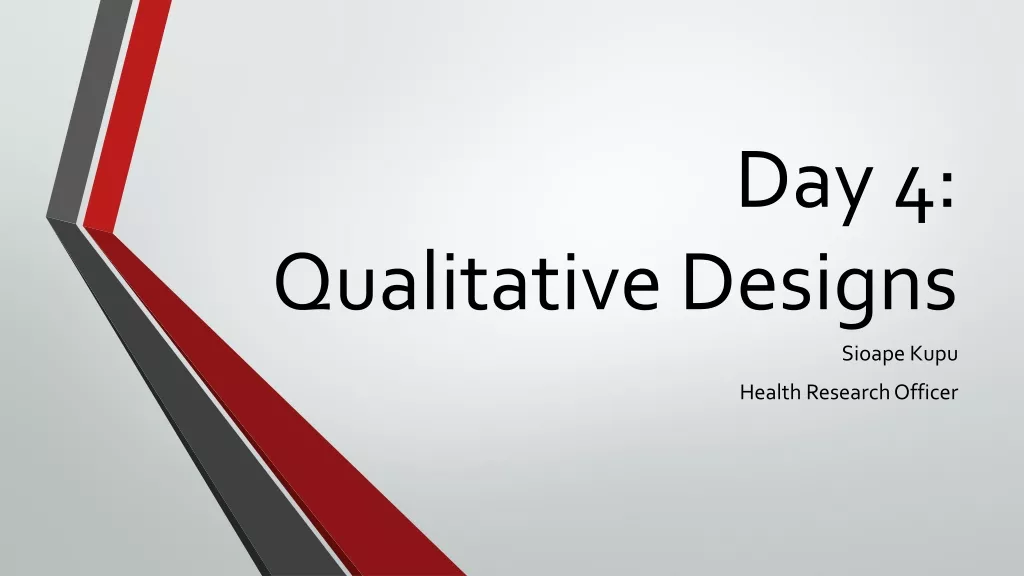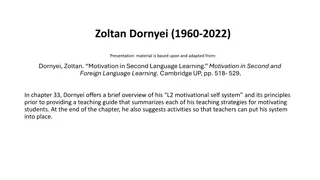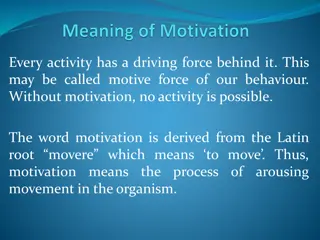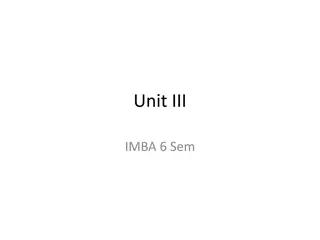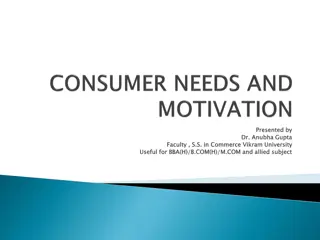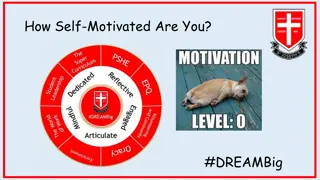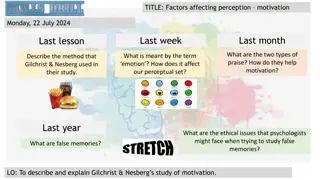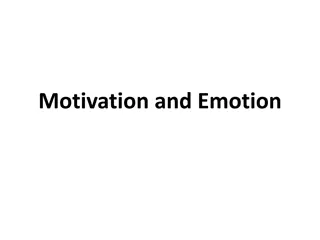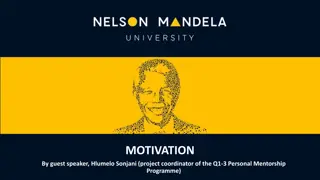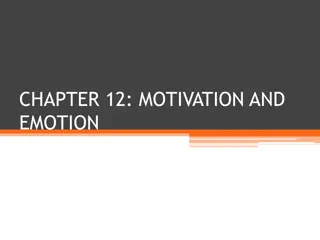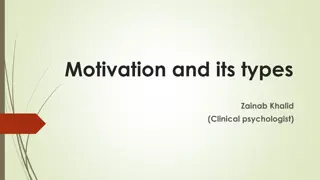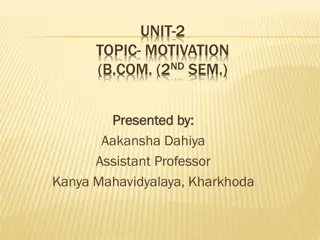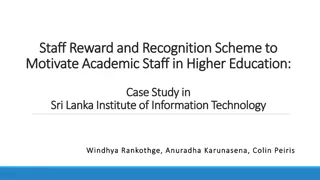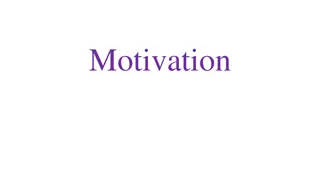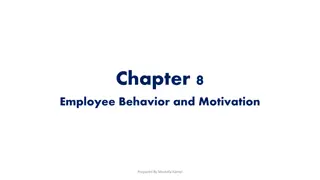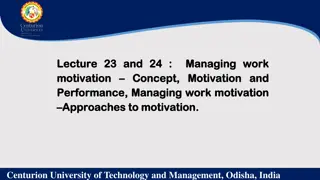Motivation
Motivation is the driving force behind individual behavior in organizations, influencing intensity, direction, and persistence of effort towards goals. It plays a crucial role in enhancing efficiency, reducing absenteeism and turnover, fostering team spirit, minimizing wastages, promoting innovation, optimizing resource use, and enhancing corporate image. These factors collectively contribute to a positive work environment and organizational success.
Download Presentation

Please find below an Image/Link to download the presentation.
The content on the website is provided AS IS for your information and personal use only. It may not be sold, licensed, or shared on other websites without obtaining consent from the author.If you encounter any issues during the download, it is possible that the publisher has removed the file from their server.
You are allowed to download the files provided on this website for personal or commercial use, subject to the condition that they are used lawfully. All files are the property of their respective owners.
The content on the website is provided AS IS for your information and personal use only. It may not be sold, licensed, or shared on other websites without obtaining consent from the author.
E N D
Presentation Transcript
Motivation UNIT-3
Motivation Motivation is the word derived from the word motive which means needs, desires, wants or drives within the individuals. It is the process of stimulating people to actions to accomplish the goals. In the work goal context the psychological factors stimulating the people s behavior can be - desire for money success recognition job-satisfaction team work, etc
Defining Motivation Motivation The processes that account for an individual s intensity, direction, and persistence of effort toward attaining a goal. Key Elements Intensity: how hard a person tries Direction: toward beneficial goal Persistence: how long a person tries
Importance of motivation in an organization: 1. Greater efficiency: Motivation enhances the efficiency of the employees and of organization. When employees are motivated, they can perform with commitment and dedication. 2. Reduction in absenteeism and labor turnover: Motivated employees may not remain absent or leave the organization. They develop a sense of belonging towards the organization and thus improve their overall performance. 3. Team spirit: Motivation improves team spirit of employees, and this improves the work environment and the overall performance of the employee and the organization.
Importance of motivation in an organization: 4. Reduction in wastages and breakages: Motivated employees take great care in handling machines and other resources. This will reduce wastages and breakages, thus resulting in higher benefits to the organization. 5. Cordial relations: Motivation enables cordial and healthy relationship in the organization. Motivation helps reduce labor grievances and disputes. It ensures sound relations between the management and the labor. It improves the overall efficiency of the organization. 6. Promotion of innovation: Motivated employees use their initiative to find out innovative ways in the performance of their operations. Such employees are more creative and help the organization to gain the competitive advantage.
Importance of motivation in an organization: 7. Optimum use of resources: Motivation leads to greater employee involvement and lesser wastages. This leads to optimum utilization of resources. 8. Corporate image: Motivated employees are more loyal to the organization. They work with a sense of commitment and dedication. This improves the overall performance of the employee, which enables better results for the company. This results in better relations with all the stakeholders.
Characteristics/Features of Motivation: 1. Interaction between the individual and the situation: Motivation is not a personal trait but an interaction between the individual and the situation. 2. Goal-directed behavior: Motivation leads to an action that is goal oriented. Motivation leads to accomplishment of organizational goals and satisfaction of personal needs. 3. Systems oriented: Motivation is influenced by two forces: a. Internal forces: These forces are internal to the individual, i.e., their needs, wants and nature. b. External forces: These forces are external to the individual, which may be organizational related such as management philosophy, organizational structure, and superior- subordinate relationship, and also the forces found in the external environment such as culture, customs, religion and values.
Characteristics/Features of Motivation: 4. Positive or negative: Positive motivation or the carrot approach offers positive incentives such as appreciation, promotion, status and incentives. Negative motivation or stick approach emphasizes penalties, fines and punishments. 5. Dynamic and complex in nature: Human behavior is highly complex, and it becomes extremely difficult to understand people at work. Motivation is a dynamic and complex process.
THEORIES OF MOTIVATION
ContentTheories: 1.Maslow HierarchyOfNeeds: Maslow's hierarchy of needs is a theory in psychology proposed by Abraham Maslow in his 1943 paper "ATheory of Human Motivation" in psychological Review. Maslow subsequently extended the idea to include his observationsof humans'innatecuriosity. Human behavior is goal-directed. Motivation cause goal-directed behaviour. It is through motivation that needs can be handled and tackled purposely. This can be understood by understanding the hierarchy of needs by manager. The needs of individual serves as a driving force in human behaviour. Therefore, amanager must understand the hierarchy of needs . Maslow hasproposed TheNeedHierarchy Model . 11
2.Herzbergs Motivation-HygieneTheory: The Herzberg s Motivation-Hygiene Theory is given by Fredrick Herzberg and his associates, who studied the variables that are perceived to be desirable to achieve goals and the undesirable conditions to avoid. In this context, the study was conducted wherein the experiences and feelings of 200 engineersandaccountantswereanalyzed. They were asked to share their previous job experiences in which they felt exceptionally good or exceptionally bad. Through this study, Herzberg concluded that there are two job conditions independent of each other that affect thebehaviordifferently. 13
The first set of job conditions has been referred to as maintenance or hygiene factor, wherein the same job conditions provide the same level of dissatisfaction, in case the conditions are absent, however, their presence does not motivatein astrongway. The second setof job conditions is referred to asmotivational factors, which primarily operateto build strongmotivation andhigh jobsatisfaction, but their absencedoesnot result in strongdissatisfaction. 14
Hygiene Factors: Herzberg identified ten maintenance or hygiene factors, that are not intrinsic parts of ajob, but are related to the conditions in which the job has to beperformed. Theseare company policy and administration, technical supervision, job security, working conditions, interpersonal relationship with peers, subordinates andsupervisors,salary,job security,personal life, etc. Motivational factors: These factors have a positive effect on the functioning of the employees in the organization. There are six factors that motivate employees: Achievement, Recognition, Advancement, Work-itself, Possibility of growth and Responsibility. An increase in these factors satisfies the employees and the decrease in thesewill not affectthe level ofsatisfaction. Thus, Herzberg s Motivation-Hygiene Theory studied the variables which were responsible for the level of satisfaction and had been applied in the industry that hasgiven severalnew insights. 15
3.McClellands Needs Theory: McClelland s Needs Theory was proposed by a psychologist David McClelland, who believed that the specific needs of the individual are acquired over a period of time and gets moldedwith one s experience of the life. McClelland s Needs Theory is sometimes referred to asThree Need theory or Learned NeedsTheory. Need for Power (n-pow): What is Power? Power is the ability to induce or influence the behavior of others.Thepeople with high power needsseekhigh-level positions in the organization, soasto exerciseinfluence andcontrol over others. Generally, 12 theyare
outspoken,forceful, demanding,practical/realistic-not sentimental, andlike to get involved in theconversations. Need for Affiliation (n-affil): People with high need for affiliation derives pleasure from being loved by all and tend to avoid the pain of being rejected. Since, the human beings are social animals, they like to interact and be with others where they feel, people accept them. Thus,people with theseneedslike to maintain the pleasant social relationships, enjoy the sense of intimacy and like to help andconsoleothersatthetime oftrouble. Need for Achievement (n-ach): McClelland found that some people have an intense desire to achieve. He has identified the following characteristics of high achievers: 17
High achieverstakethemoderaterisks,i.e.acalculatedrisk while performing the activities in the management context. This is opposite to the belief that high achieverstakehigh risk. High achievers seek to obtain the immediate feedback for the work done by them, so as to know their progress towards the goal. Once the goal is set, the high achiever puts himself completely into the job, until it gets completed successfully. He will not be satisfied until he has given his 100% in the task assignedto him. Hence,McClelland s NeedsTheorypositsthat theperson s level of effectiveness and motivation is greatly influenced by these three basicneeds. 18
4.Alderfers ERGTheory: Alderfer s ERG Theory is the extension of Maslow s Needs Hierarchy, wherein the Maslow s five needs are categorized into three categories,Viz. ExistenceNeeds,RelatednessNeeds,andGrowth Needs. An American psychologist Clayton Paul Alderfer had proposed this theory and believed that each need carries some value and hence can be classified as lower-order needs and higher-order needs. He also found some level of overlapping in the physiological, security and social needs along with an invisible line of demarcation between the social, esteem and self- actualization needs. This led to the formation Alderfer s ERG theory, which comprisesof thecondensedform of Maslow sneeds. Existence Needs: The existence needs comprises of all those needs that relate to the physiological and safety aspects of human beings and are a prerequisitefor thesurvival. 19
Thus, both the physiological and safety needs of Maslow are grouped into one category because of their same nature and a similar impact on the behavior of anindividual. Relatedness Needs: The relatedness needs refer to the social needs, that an individual seeks to establish relationships with those for whom he cares. These needs cover the Maslow s social needs and a part of esteem needs, derivedfrom therelationship with otherpeople. Growth Needs:The growth needs cover Maslow s self-actualization needs as well asapart of esteemneedswhich are internal to the individual, such asa feeling of beingunique, personnelgrowth,etc. Thus,growth needsarethoseneedsthat influence an individual to explorehis maximum potentialin theexisting environment. 20
ProcessTheories: 1.Vroom s Expectancy Theory :Vroom s Expectancy Theory was proposed by Victor. H. Vroom, who believed that people are motivated to perform activities to achieve some goal to the extent they expect that certain actions ontheir part would help them to achievethegoal. Vroom s Expectancy Theory is based on the assumption that an individual s behavior results from the choices made by him with respect to the alternative course of action, which is related to the psychological events occurring simultaneously with the behavior. This means an individual selects a certain behavior over the other behaviors with an expectation of getting results, the one desired for. Thus, Vroom s Expectancy Theory has its roots in thecognitive concept,i.e.how anindividual processesthedifferent elements of motivation. 21
This theory is built around the concept of valence, instrumentality, and Expectancy and, therefore, is often called as VIEtheory. The algebraic representation of Vroom s Expectancy theoryis: Motivation (force) = Valence xExpectancy 22
Expectancy a persons belief that more effort will result in success. If you work harder,it will result in betterperformance. Instrumentality the person s belief that there is a connection between activity and goal. If you perform well, you willget reward. Valence the degree to which a person values the reward, the results of success. 2.Adam sEquityTheory: The Adam s Equity Theory posits that people maintain a fair relationship between the performance and rewards in comparison to others. In other words, an employee gets de-motivated by thejob and his employer in case his inputs are more than the outputs. The Adam s Equity Theory was proposed by John Stacey Adams, and is based on the following assumptions: Individuals make contributions (inputs) for which they certain rewards 19 (outcomes).
To validate the exchange, an individual compares his input and outcomes with those of others and try to rectify the inequality. There are three types of exchange relationships that arise when an individual input/outcomes are comparedwith that of theotherpersons. 1.Overpaid Inequity: When an individual perceives that his outcomes are more as compared to his inputs, in relation to others. The overpaid inequity can beexpressed as: 2.Underpaid Inequity: When an individual perceives that his outcomes are lessas compared to his inputs, in relation to others. The Underpaid Equity can be expressedas: 24
3.Equity: An individual perceives that his outcomes in relation to his inputs are equal to those of others. The equity can be expressedas Thus, Adam s equity theory shows the level of motivation among the individuals in the working environment. An individual is said to be highly motivated if he perceives to be treated fairly. While the feelings of de-motivation arise,if anindividual perceivesto betreatedunfairly in theorganization. 25
3.GOAL SETTINGTHEORY: In 1960 s, Edwin Locke put forward the Goal-setting theory of motivation. This theory states that goal setting is essentially linked to task performance. It states that specific and challenging goals along with appropriate feedback contribute to higher and better task performance. The important featuresofgoal-settingtheoryareasfollows: The willingness to work towards attainment of goal is main source of job motivation. Clear, particular and difficult goals are greater motivating factors than easy, general and vague goals. Specific and clear goals lead to greater output and better performance. Unambiguous, measurable and clear goals accompanied by a deadline for completion avoids misunderstanding. Goals should be realistic and challenging. This gives an individual afeeling of pride andtriumph when heattainsthem,andsetshim up for attainment of nextgoal. 22
The more challenging the goal, the greater is the reward generally and the more is the passion for achieving it. Better and appropriate feedback of results directs the employee behaviour and contributes to higher performance than absenceof feedback. Feedback is a means of gaining reputation, making clarifications and regulating goal difficulties. It helps employees to work with more involvement andleadsto greaterjob satisfaction. Employees participationin goalisnot alwaysdesirable.Participation of setting goal,however,makesgoalmoreacceptableandleadsto more involvement. goalsetting theory hascertain eventualities suchas: a.Self-efficiency- Self-efficiency is the individual s self-confidence and faith that he has potential of performing the task. Higher the level of self-efficiency, greater will betheefforts put in bytheindividualwhen they facechallenging tasks. 27
While, lower the level of self-efficiency, less will be the efforts put in by the individual or hemight evenquit while meetingchallenges. b.Goal commitment- Goal setting theory assumes that the individual is committed to the goal and will not leave the goal. The goal commitment is dependenton thefollowing factors: Goalsaremadeopen,known and broadcasted. Goalsshouldbeset-selfbyindividual rather thandesignated. Individual s set goals should be consistent with the organizational goals and vision. 28
4.ReinforcementTheory: This theory is based on the concepts of operand conditioning developed by B.F . Skinner. It argues that the behavior of people is largely determined by its consequence. In other words, those actions that tend to have positive or pleasant consequences tend to be repeated more often in future, while those actions that tend to have repeated negative or unpleasant consequences are lesslikely to berepeated again. The reinforcement theory suggests that managers should try to structure the contingencies of rewards and punishments on the job in such a way that the consequences of effective job behavior are positive while the consequences of ineffective work behavior are negative or unpleasant. The focus of this approach is upon changing or modifying the behavior of people on the job. that iswhy it isalsoregardedasorganizational behaviormodification. 29
The basic notion underlying reinforcement theory is the concept of reinforcement itself. An event is said to be reinforcing if the event following somebehavior makesthe behavior more likely to occur again in the future. In organizational settings,four basickinds of reinforcement canresultfrom behavior 1.Positive Reinforcement: A method of strengthening behavior with rewards or which is discussed briefly as under: positive outcomes after a desired behavior is performed. 2. Avoidance / Negative reinforcement: Used to strengthen behavior by avoiding unpleasant consequences that would result if the behavior was not performed. 3.Punishment: Used to weaken undesired behaviors by using negative outcomes orunpleasant consequence when the behavior is performed. 4. Extinction: Used to weaken undesired behaviors by simply ignoring ornot reinforcing that behavior. 31


